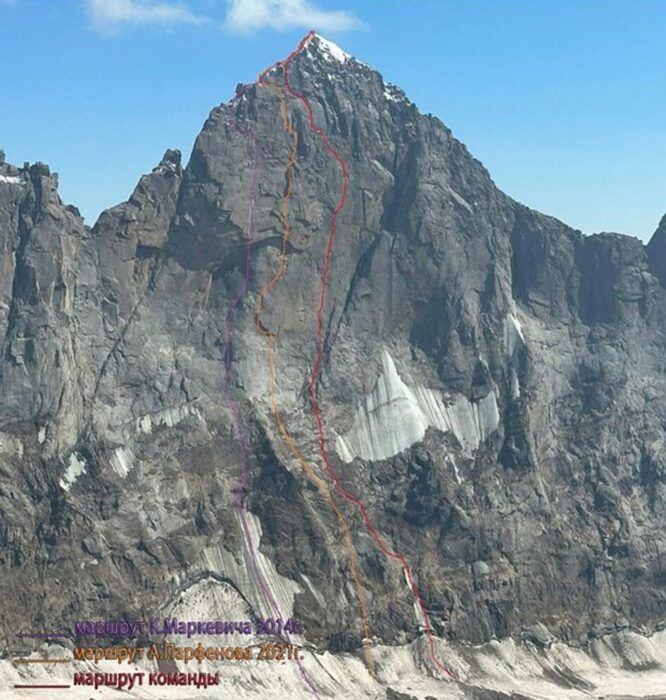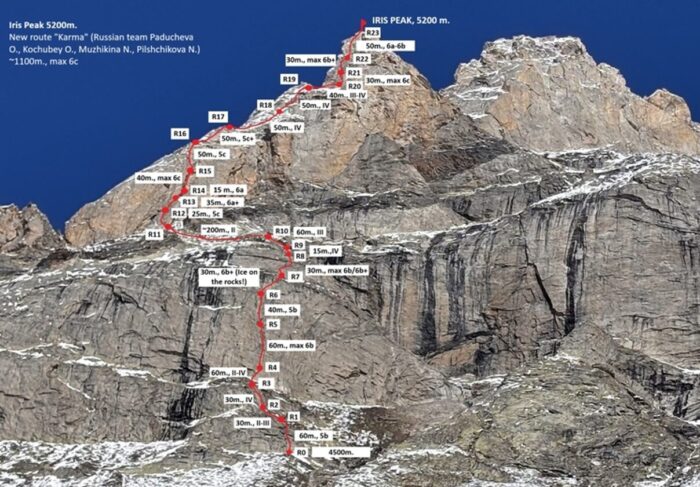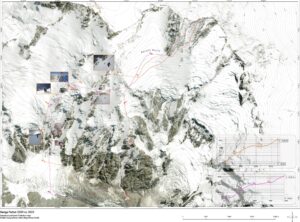The Russian Mountaineering Association has published its shortlist of candidates in their version of the Piolets d’Or. The list features two alpine-style ascents of 8,000m peaks: the new route on the Southwest Face of Manaslu by Andrey Vassiliev’s team and the Nanga Parbat line by Denis Urubko and Maria Cardell.
A jury will decide the single winner of the Russian Golden Ice Axe from the four contenders below at a gala in Moscow on November 29.
8,000’ers
The new route on Manaslu’s Southwest Face by Andrey Vasilyev, Sergei Kondrashkin, Kirill Eizeman, Natalia Beliankina, and Vitaly Shipilov. They completed the route in a single, alpine-style push, having previously acclimatized on the normal route of 8,163m Manaslu. Furthermore, they descended by a different line, in difficult conditions and unknown terrain.

The new Russian route on the Southwest Face of Manaslu. Photo: Federation of Alpinism of Russia (FAR)
Second on the list, which is in no particular order, is the alpine-style Nezabudka route by Denis Urubko of Russia and Maria Cardell of Spain on Nanga Parbat (8,125m), from the Diamir (northern) side of the mountain. They completed the climb, which includes sections exposed to avalanches and rockfall, in rough weather conditions.

Maria Cardell and Denis Urubko this summer in Skardu. Photo: Denis Urubko/Alpine Adventure Guides
Kyrgyzstan Big Wall
Also a finalist is the new route on Kyrgyzstan’s Svarog (5,100m) by Evgeny Matveenko, Evgeny Korulin, Artem Pivovarchik, and Tikhon von Stackelberg.

The new route on Svarog, nominated for the Russian Piolet d’Or, is marked in red. Photo: FAR
Pik Svarog lies in the Ashat Gorge of the Pamir-Alay range. While not the highest peak in the area (Mt. Sabakh is 300m higher), Svarog has the steepest north face. It rises more than 1,000m above the bergschrund, according to the American Alpine Journal.
This year’s climb, rated 6B, goes up the center of the northwest face. There are only two previous ascents of that face, both by Russian teams, in 2014 and 2021. Both followed different lines.
A new women’s route in India
An all-female team of O. Paducheva, O. Kochubei, N. Pilshchikova, N. Muzhikova completed Karma, a new route on Iris Peak (5,200m), in the Indian Himalaya. The 1,100m route has two sections of varied difficulty, according to the climbers: a 650m first part up a vertical wall rated as 6c, ED and a second, easier 550m upper section, rated as PD/AD.

The Karma route has two distinctive sections: up a wall on the lower half and along the peak’s flank to the summit on the upper half. Photo: FAR
The team had originally planned for a new route on White Sapphire Peak in Kishtwar, but the conflict between India and Pakistan last spring, plus several difficulties traversing flooded areas, forced them to look for an alternative goal in the Zanskar region.






